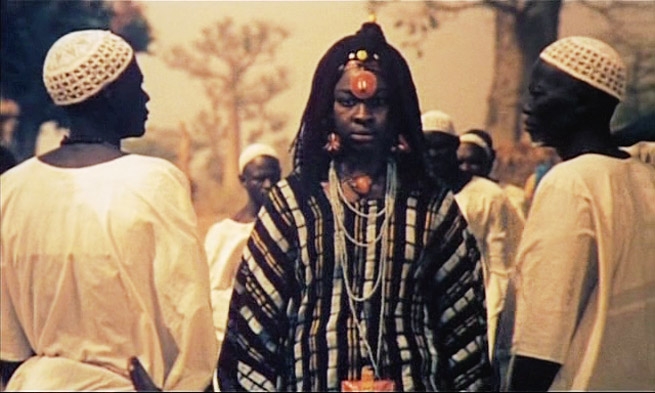In Senegalese director Ousmane Sembène’s Ceddo (1977), a village king embraces Islam and, with the support of a cruel imam, tries to force all his subjects to convert. A key example of African Third Cinema, the film was screened on the 8th of July as the first in ICA’s new Cinematheque season, ‘We Must Discuss, We Must Invent!’, which ‘explores the artist’s role in bringing focus to a constantly changing world’.
The notion of re-thinking the world is crucial to Third Cinema, a type of revolutionary filmmaking primarily associated with Latin America, Africa and Asia. It is cinema for the people, focusing on local issues, and opposing the establishment—the cinematic establishment of Hollywood’s entertainment industry, but equally the establishment of dominant government, culture and religion. In Senegal, the establishment was the French coloniser and Christianity.
When national hero Lat Dior converted to Islam as an act of rebellion against the French in the 1860s, being Muslim seemed revolutionary. But with a majority Muslim population, when Senegal gained its independence from France a century later, Islam was the new establishment. Sembène’s film portrays Islam as yet another set of practices imposed from outside, intended to wipe out local cultural and animist traditions. Even if the film’s unflattering image of Islam can be understood as a deliberately partisan perspective intended to highlight injustice, Ceddo was controversial enough to be banned for 8 years by Senegal’s president, Léopold Sédar Senghor.
Ceddo presents a parallel between declining French powers and rising Muslim ones. The French seem diminished and isolated, represented by just two characters, a slave trader and a priest, who don’t speak a single line in the film. If Christianity seems a mild religion next to Islam, it is because it no longer has any sway: the church is virtually empty, and the priest has nothing to do. In a fantasy sequence, the priest imagines a huge congregation, complete with young nuns, gathering to sing songs and take communion. When the camera pulls back and reveals the priest lying in a coffin, it also reveals the egotism underlying his dream. For him, a Christian resurgence is all about restoring his own prestige, not saving his parishioners’ souls.
The slave trader, meanwhile, remains powerful, because of the material goods only he can provide. The village women line up outside his shop to trade chickens for sheets of paper, but this inoffensive exchange is a negligible part of his amoral enterprise. Crucially, he offers instruments of power, guns, in exchange for human beings, which he brands heartlessly with the French fleur-de-lys, unopposed by king or imam.
Faced with an issue that troubles them, the villagers are used to their traditional councils: everyone is invited for an audience with the king where they can raise their concerns and argue their point of view. Early in the film, before the unarguable laws of religion start to erode this democracy, the villagers gather before the king to explain that they have kidnapped his daughter as a protest against forced conversion. Commoners and nobles alike take turns speaking to the king, describing how things used to be and why they’re worried about changes to age-old customs. It’s an effective, if over-long, method of setting up the story: introducing the major characters and clearly setting out what’s at stake.
The film’s audience is mirrored by an audience within the film: the council takes place as a form of theatre-in-the-round, with villagers on one side, the powerful on the other, and speakers in the middle, expressing their views with rhetorical language and passionate gesture. Here, and elsewhere in the film, the speakers use local sayings that are visually evocative, sometimes hilariously so: ‘The wind that knocks down the baobab tree only bends the stem of millet’, or ‘The man who wears trousers of fat should not approach the fire’. The restricted number of props and the natural minimalism of the arid environment recall the purity and simplicity of theatrical space. And the fact that all of the villagers’ clothing appears to have been made from just two or three different patterns of cloth gives a visual unity in this scene where everyone can be seen together at a glance.
Most of these elements that make the film theatrical also come across as naturalistic in their context: the circular arrangement of the village council to give everyone a clear view of the action; the passionate language of those who have a lot to lose; and restricted material possessions in a dry and isolated place. Sembène’s use of music, on the other hand, is not so naturalistic. Unlike a lot of film music, which blends into the background, Sembène’s leaps to the fore, startling the audience. Music that comes from within the film (people singing or playing drums, for example) is naturalistic, but the music that only the audience can hear feels jarring or even alien.
When we first see the shackled prisoners in the slave trader’s yard, Sembène plays spirituals, presumably to make a link with slaves in the American South. But the same music is used when the imam instructs the faithful to persecute villagers who refuse to convert: as people flee their burning houses, the spiritual symbolises people’s broader suffering at the hands of various unjust powers throughout history, as well as the hope of salvation. Even more startling is the use of a contemporary 1970s tune that sounds like it was ripped straight from the soundtrack of Shaft: it seems completely incongruous when it’s first used during the re-naming ceremony for forced converts, but it foreshadows a return, a few scenes later, as a fitting theme for the film’s spectacular ending.
ICA’s Cinematheque season devoted to Third Cinema resumes on the 5th of August with Margot Benacerraf’s Araya (Venezuela, 1959), followed by Terra em transe (19 August) by Brazilian Cinema Novo director Glauber Rocha (1967), and concludes on the 2nd of September with Mikhail Kalatozov’s stunning visual masterpiece Soy Cuba (1964).

